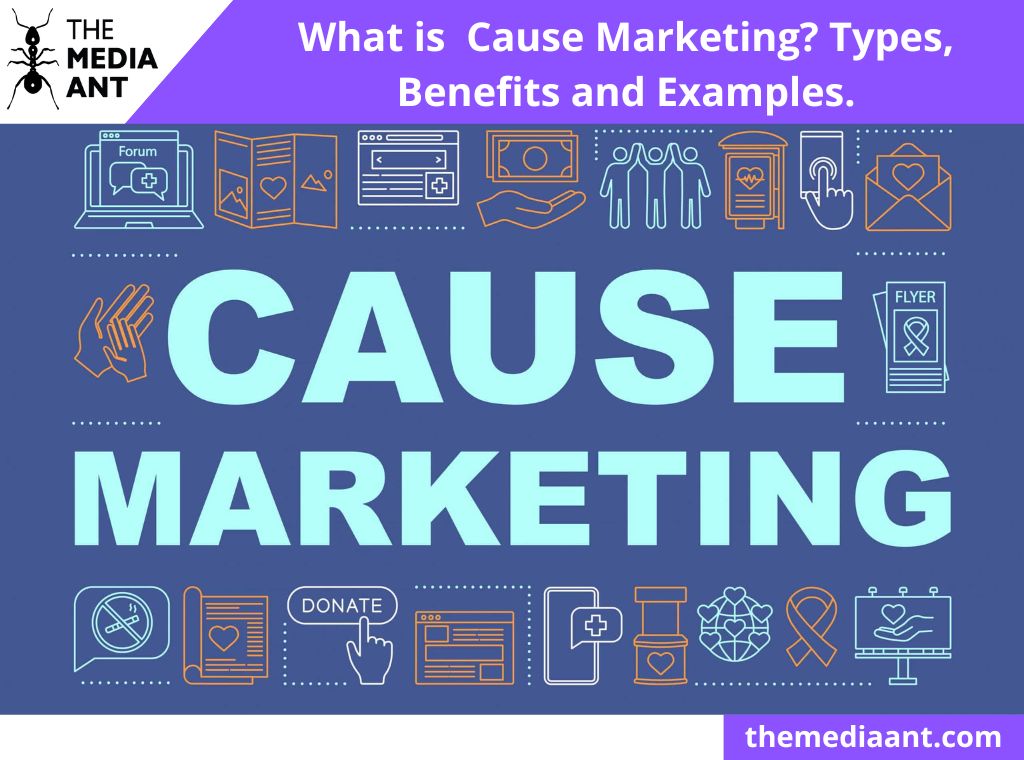In an era where consumers are more socially conscious than ever, they seek brands that align with their values. Cause marketing allows businesses to demonstrate their commitment to societal issues, differentiating themselves from competitors and fostering deeper connections with their target audience. It’s not just about putting up a charity logo on a product it’s about genuine collaboration and making a tangible difference. Let’s dive into the realm of cause marketing to understand its types and benefits.
Cause Marketing Meaning
Cause marketing, often referred to as cause-related marketing, is a collaborative effort between a for-profit business and a non-profit organization to promote a social or environmental cause. This partnership aims to benefit both parties, the business gains positive publicity and increased customer loyalty, while the non-profit receives financial support and heightened awareness for its cause.
Benefits Of Cause Marketing

Cause marketing has emerged as a powerful strategy for businesses and non-profits alike. By aligning with a social or environmental cause, companies can not only boost their bottom line but also make a positive impact on society. Here’s a deeper dive into the manifold benefits of cause marketing:
Enhanced Brand Image:
In today’s socially conscious world, consumers are increasingly drawn to brands that stand for something more than just profits. Engaging in cause marketing can significantly elevate a company’s reputation, painting it as ethical, compassionate, and socially responsible. This enhanced brand image can differentiate a business in a crowded market and make it more appealing to consumers.
Increased Customer Loyalty:
Modern consumers don’t just buy products, they buy values. When a company aligns with a cause that resonates with its target audience, it fosters a deeper emotional connection. This bond can translate into increased customer loyalty, repeat purchases, and brand advocacy. In essence, consumers are more likely to stick with brands that reflect their personal beliefs and values.
Higher Employee Morale:
The benefits of cause marketing aren’t limited to external stakeholders. Internally, employees often feel a sense of pride and fulfillment when their employer is involved in meaningful charitable endeavors. This can lead to increased job satisfaction, higher retention rates, and a more motivated workforce. Employees want to work for companies that make a difference, and cause marketing provides that sense of purpose.
Financial Growth:
While the primary aim of cause marketing is to support a worthy cause, it can also have tangible financial benefits. Studies have shown that consumers are often willing to pay a premium for products associated with a charitable cause. Moreover, a successful cause marketing campaign can lead to increased sales, as consumers choose to support brands that give back.
Greater Media Exposure:
Cause marketing campaigns, especially those that are innovative or tied to pressing societal issues, often attract media attention. This can result in free publicity, further amplifying the brand’s message and reach. Such media exposure not only boosts brand visibility but also raises awareness for the associated cause.
Strengthened Stakeholder Relationships:
Engaging in cause marketing can also enhance a company’s relationships with various stakeholders, including investors, suppliers, and partners. Many stakeholders today prioritize corporate social responsibility when deciding which companies to support or collaborate with.
Long-Term Strategic Alignment:
Cause marketing can also pave the way for long-term strategic partnerships between businesses and non-profits. These collaborations can lead to joint initiatives, shared resources, and combined expertise, all aimed at creating a larger impact on the chosen cause.
Types Of Cause Marketing

Cause marketing has evolved over the years, adapting to the changing needs of society and the increasing demand from consumers for businesses to play a role in addressing social and environmental issues. As a result, various types of cause marketing strategies have emerged, each with its unique approach and benefits. Here’s a deeper dive into the different types:
Transaction-Based Campaigns:
This is one of the most common forms of cause marketing. For every purchase of a specific product or service, a company pledges to donate a certain amount or percentage to a designated cause.
Licensing Campaigns:
In this model, non-profit organizations allow companies to use their logos, names, or branding in exchange for a fee or a portion of the sales from the promoted product. The Pink Ribbon symbol, representing breast cancer awareness, is licensed to various companies, and a portion of the sales from products bearing the symbol goes towards breast cancer research.
Message Promotion:
Here, companies collaborate with non-profits to amplify a specific message or awareness campaign. While there might not be a direct ask for donations, the primary goal is to raise awareness and educate the public. Dove’s partnership with various organizations to promote body positivity and self-esteem among women and girls.
Employee Engagement:
Companies motivate their employees to get involved in charitable activities, either through volunteering, fundraising, or direct donations. Often, companies will match employee contributions or provide incentives for volunteer hours. Microsoft’s Employee Giving Program matches employee donations and provides grants to organizations where employees volunteer.
Sponsorships:
Businesses provide financial backing for a non-profit’s event, program, or initiative. In return, they receive publicity and association with the cause, often through branding opportunities at the event or in promotional materials. Johnson Tiles partnered with the NGO Enable India to build red ramps in public spaces across India. Red ramps are designed to be more visible to people with visual impairments, and they help to make it easier for them to navigate their surroundings.
Cause-Related Products:
Companies create specific products where a portion of the sales or profits are directed towards a cause. These products are often co-branded with the non-profit or carry a special design signifying the partnership.
Joint Fundraising:
Both the company and the non-profit collaborate to raise funds together. This can be through events, online campaigns, or other fundraising initiatives. Ariel India in 2015 was launched a campaign to challenge gender stereotypes about household chores. Ariel partnered with the NGO Plan India to raise awareness about the issue of gender inequality. The campaign was a huge success, and it helped to change the way people think about household chores.
Create Better Solutions

Create Better Solutions underscores the importance of going beyond superficial gestures and diving deep into the root causes of societal issues. It’s about evolving from mere transactional partnerships to transformative collaborations that bring about lasting change. Let’s delve deeper into what this means and why it’s crucial for the future of cause marketing.
Understanding the Root Causes
To create better solutions, businesses, and non-profits must first understand the underlying issues they aim to address. This involves comprehensive research, engaging with affected communities, and collaborating with experts in the field. By grasping the root causes, organizations can design interventions that are more effective and sustainable.
For instance, addressing child hunger isn’t just about providing meals. It’s about understanding the systemic issues like poverty, lack of education, and unemployment that lead to food insecurity in the first place.
Innovative Collaborations
The next step is fostering innovative collaborations. Traditional cause marketing often involves a business supporting a non-profit through financial donations or promotional efforts. While this is commendable, “Create Better Solutions” pushes for more integrated partnerships.
Imagine a tech company partnering with an educational non-profit. Instead of just donating money, the company could develop educational software, offer mentorship programs, or even establish tech hubs in underserved communities. Such deep-rooted collaborations ensure that the impact is long-lasting and transformative.
Measuring Impact
Creating better solutions also means continuously measuring and evaluating the impact of cause marketing initiatives. It’s not enough to launch a campaign and hope for the best. Organizations must track their efforts, gather data, and assess whether they’re making a genuine difference. This iterative approach ensures that campaigns remain effective and can be adapted based on real-world results.
Engaging the Community
At the heart of any successful cause marketing initiative is the community it serves. “Create Better Solutions” emphasizes the importance of involving the community in decision-making processes. This could mean conducting surveys, hosting focus groups, or even co-creating campaigns with community leaders. When the beneficiaries have a say in the solutions, the outcomes are more likely to be relevant and impactful.
Sustainability Over Short-Term Gains
Lastly, this approach prioritizes sustainability over short-term gains. While it’s tempting to opt for quick fixes that look good in annual reports or marketing materials, lasting change requires a long-term commitment. This might mean investing in infrastructure, education, or capacity-building initiatives that don’t yield immediate results but pave the way for a brighter future.
Examples Of Cause Marketing
Tata Tea’s “Jaago Re” Campaign:
Tata Tea, one of India’s leading tea brands, launched the “Jaago Re” campaign to raise awareness about the importance of voting. The campaign’s primary objective was to encourage Indian citizens to exercise their right to vote and become more responsible citizens. Through this initiative, Tata Tea aimed to create a positive social change by urging people to be proactive in their civic duties.
Lifebuoy’s “Help a Child Reach 5” Campaign:
Lifebuoy, a renowned soap brand in India, collaborated with UNICEF to promote the habit of handwashing and reduce child mortality rates due to preventable diseases. The campaign’s focus was on educating individuals, especially in rural areas, about the significance of handwashing. By emphasizing the link between hygiene and health, Lifebuoy aimed to make a tangible difference in communities.
P&G’s “Shiksha” Campaign:
Procter & Gamble’s “Shiksha” campaign was designed to support education for underprivileged children in India. For every purchase of select P&G products, a part of the proceeds was channeled towards building and supporting schools in rural regions. This initiative showcased P&G’s commitment to improving educational opportunities for children in need.
Coca-Cola’s “Support My School” Campaign:
Coca-Cola India’s “Support My School” campaign was centered on enhancing the infrastructure and amenities of schools in rural India. The initiative aimed to provide essentials like clean drinking water, sanitation facilities, and sports equipment to improve the overall learning environment for students. By investing in the future of these children, Coca-Cola demonstrated its dedication to community development.
Whisper #Touch The Possibilities Campaign:
This campaign was launched in 2018 and aims to break the silence around menstruation and empower women to talk about it freely. Whisper has partnered with UN Women to launch this campaign in India and has also partnered with celebrities and influencers to raise awareness about the issue.
Nihar Hair Oil for Education campaign:
The campaign is a social responsibility initiative by the hair care brand Nihar Naturals. The campaign was launched in 2016 and features Bollywood actor Vidya Balan as the brand ambassador. The campaign aims to raise awareness about the importance of education and to help underprivileged children get access to quality education. Nihar Naturals contributes 5% of its profits from the sale of Nihar Shanti Amla hair oil to this cause.
FAQs Related to Cause Marketing
What is an example of cause-related marketing?
Cause-related marketing involves a partnership between a business and a non-profit to promote a social cause. A classic example is the “Product Red” initiative, where brands like Apple collaborate with the Global Fund to fight diseases such as AIDS by donating a portion of their sales.
What are the types of cause marketing?
Cause marketing can be categorized into several types: transaction-based campaigns, licensing campaigns, message promotion, employee engagement, and sponsorships. Each type represents a different approach to supporting a cause through business endeavors.
What are the benefits of cause marketing?
Cause marketing offers numerous benefits, including an enhanced brand image, increased customer loyalty, higher employee morale, financial growth, and greater media exposure. It allows businesses to align with societal values, fostering deeper connections with consumers.
What is cause marketing analysis?
Cause marketing analysis involves evaluating the effectiveness and impact of a cause marketing campaign. It assesses factors like brand perception, sales growth, and the tangible benefits delivered to the partnered non-profit. This analysis helps businesses understand the ROI and societal impact of their cause-related efforts.
What is one example of Cause Marketing?
One notable example of cause marketing is TOMS Shoes’ “One for One” model. For every pair of shoes purchased, TOMS donates a pair to a child in need, ensuring that with every product you purchase, TOMS will help someone in need.





